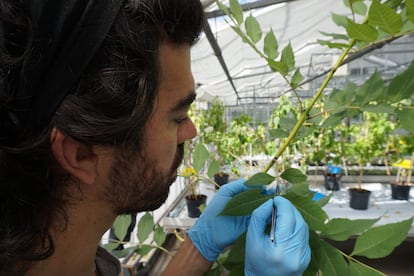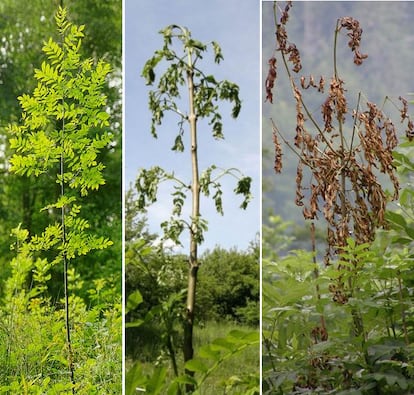A fungus invades Spain and kills almost all the ash trees it finds.
A catastrophe is silently unfolding in Spain and the rest of Europe. Almost all the ash trees are dying, everywhere. An invasive fungus, originating from Asia, is sweeping across the European continent from east to west, causing up to 80% of the trees to die, turning them into heaps of dry branches. The philosopher Miguel de Unamuno was one of the first intellectuals to reflect on the intimate link between the landscape and the culture of a people. He himself wrote of a person who “had the elegance of the ash tree .” In Episodios Nacionales (National Episodes ), a character played by Benito Pérez Galdós celebrates the majesty of this forest giant, which reaches 40 meters in height. “Botany, I understand, also includes large vegetation, for example, cork oaks and ash trees. In Spain, we have few trees, and the government that plants a few billion will be a sensible and knowledgeable government,” he proclaims . A new genetic study offers hope this Thursday for preventing the disappearance of ash trees by planting millions of them.
Forest geneticistMiguel Nemesio Górriz , born in Valencia 38 years ago, first detected diseased ash trees in Spain in August 2021, in the Asturian towns of Oviedo and Bulnes. He recalls his shock upon coming across the exceptional pre-Romanesque church of San Miguel de Lillo surrounded by dying trees. All the alarm bells went off. The international scientific community had already announced that the extermination of ash trees could lead to a cascade of extinctions of other related species (beetles, butterflies, grasshoppers, lichens), as has happened with Dutch elm disease , one of the worst known plant pandemics, triggered by another fungus that has wiped out millions of elm trees for half a century.
The culprit of ash blight, Hymenoscyphus fraxineus or chalara, was first observed in Europe in 1992 in Poland . One hypothesis is that it entered via a plantation of Manchurian ash trees—a different species, to which the fungus is harmless—from the eastern reaches of the Soviet Union, North Korea, or China. The pathogen, carried by the wind, travels up to 100 kilometers each year. After Poland, the fungus was observed in Sweden in 2001, Germany in 2002, Austria in 2005, France in 2008, the United Kingdom in 2012, and Spain in 2021. It has now invaded 32 European countries .

The latest report on the state of trees in Spain's national parks is shocking. The Picos de Europa National Park is already full of dead or dying ash trees. "The presence of damage consistent with H. fraxineus in most of the visited areas of the national park portends a difficult future for the species. In this regard and in other areas, the death of approximately 70-80% of ash populations due to this pathogen in Great Britain has been predicted," states the document, prepared by the Ministry for Ecological Transition and not yet published.
The report reveals the severity of the crisis. "Regarding possible measures against H. fraxineus , it is considered that, once established, its control is practically impossible, so at the present time we can only coexist with the disease," acknowledge the authors, coordinated by Dolores Rollán and Raquel Blanco of the Autonomous National Parks Agency. Picos de Europa technicians are searching for ash trees resistant or at least tolerant to the fungus, in order to reproduce them for later reintroduction. "It is estimated that between 1% and 5% of each population may possess this resistance, albeit partially," the report states.

Miguel Nemesio Górriz works for the Spanish public company Tragsa , but was previously the leading expert on ash disease in Ireland at the Irish agri-food authority Teagasc . “In Ireland, it's a common tree, and the arrival of the fungus was very visible. Ash branches started falling on cars. The wood there is used to make hurling sticks, the national sport. It had a huge impact. In Spain, it's not as visible because the ash trees are on riverbanks or in inaccessible mountain areas, so there's no awareness of the problem,” he explains.
A study by the Navarrese government confirmed in March " the unstoppable expansion of the fungus from France." According to technicians, "it has already reached the southern slopes of the Pyrenees and has spread rapidly in Navarre, although the level of damage is still low in most of the detected locations." The fungus is slow, silent at first, but over the years it eventually kills almost all the affected ash trees. Its omnipresence in Navarre has come as a surprise. "The disease is more widespread in the region than initially expected; it has probably been present there for several years and has gone unnoticed," Navarrese technicians acknowledge. This newspaper inquired on Wednesday about the situation of the ash fungus in Spain, which is responsible for forest health, but has not received a response so far.
This Thursday, Nemesio Górriz and British colleagues published a study that sheds light on the genetic profile of trees that survived the plague known as ash decline. The authors thoroughly studied some 600 specimens from the ancient forest of Marden Park in southern England. One in three young trees died in just one year, a very high mortality rate that scientists largely attribute to the fungus. Exhaustive DNA analysis shows that the profile of the most tolerant trees is highly complex, with subtle adjustments in the frequency of genetic variants at thousands of positions in the genome. The results, published in the journal Science , demonstrate that evolution by natural selection can be very rapid, in a single generation, and without requiring radical mutations, but rather a multitude of small changes. "This is good news," celebrate the authors, led by Richard Buggs of the Royal Botanic Gardens, Kew, and Richard Nichols of Queen Mary University of London. But they emphasize that they do not know if it will be sufficient.

There are already several ash genetic improvement programs in Europe, attempting to reproduce trees apparently resistant to the disease. The new work will allow for more precise selection of parents. Forestry engineer Felipe Pérez , head of the Forest Genetic Resources Department at the Ministry of Ecological Transition, explains that a working group on genetic improvement against emerging pathogens has been created under his coordination. The first meeting, he states, will be held at the end of October to decide on the first actions regarding ash. The Ministry already coordinates genetic improvement programs to obtain elms resistant to Dutch elm disease, pines strengthened against the wood nematode, and holm and cork oaks tolerant to dry spell , a disease caused by another fungus that destroys pastures. "The situation with ash is becoming increasingly worrying," warns Pérez.
It's impossible to measure the emotional impact of the disappearance of these trees in some regions. Unamuno himself said he treated "every holm oak, every ash tree personally." In a text, he captured the passionate bond between the landscape and its inhabitants: "For centuries my race lived in historical silence, in the depths of life, speaking its ancient language, its Basque; it lived in its mountains of oaks, beeches, elms, ash trees, and walnut trees [...]. The green mountains and the rugged Cantabrian Sea are what made us."
EL PAÍS





